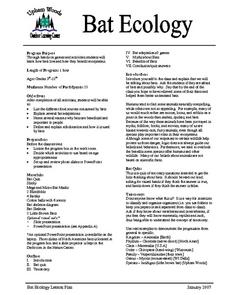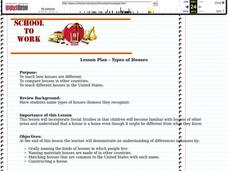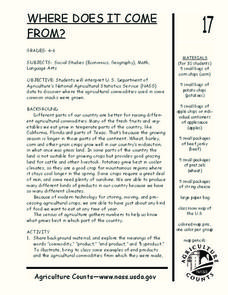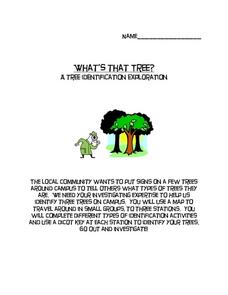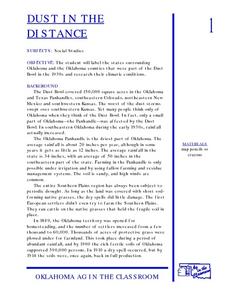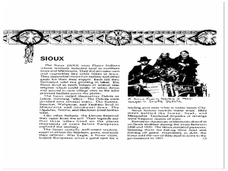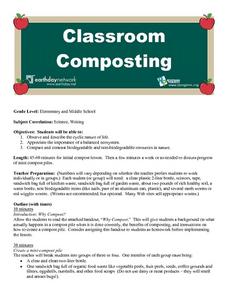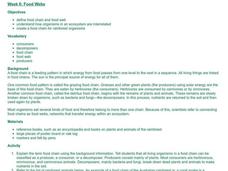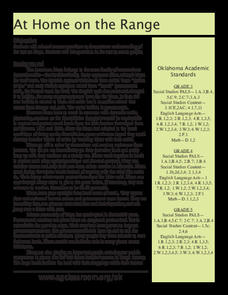Curated OER
Bat Ecology
Students, through hands on games and activities, discover how bats live and how bats benefit ecosystems. They play a game designed to show them how echolocation works and another to show how mother bats locate their young through their...
Curated OER
Dark Days on the Prairie
Learners explore U.S. geography by researching agriculture. In this dust bowl lesson plan, students complete a cause and effect worksheet based upon the dust bowls that covered a large portion of Oklahoma and Texas in the early 1900's....
Curated OER
The Buffalo War: A Clash of Cultures
Students view a documentary on the different values and meaning placed on the buffalo. Examining various cultures, they link the attitudes to the treatment of the animal in the wild. They develop solutions to the conflict raised by the...
Curated OER
Plants: Scattering Seeds
Students collect and microscopically examine seeds from the school yard and neighborhood. In small groups, they draw and discuss the shapes of the seeds to determine each plant's method of dispersal. they also test two types of seeds...
Curated OER
Olympic Solar Energy
Students use cardboard and aluminum foil to construct a solar oven that concentrates enough sunlight to cook a hotdog. They review the history and use of solar energy in relation to the Olympics.
Curated OER
Characteristics of Africa
Students describe basic land features and characteristics that make up the continent of Africa, describe the people of Africa, where they live, and how they live and get a sense of what it is like to live in Africa.
Curated OER
Types of Houses
Students orally name the kinds of houses in which people live. They name materials used in building houses in other countries. They construct a house.
Curated OER
Concern + Action = Clean Air Solutions
Students participate in a service project about improving air quality. In this air quality lesson, students understand the problems and solutions for improvement of air quality issues. Students discuss and choose an air quality service...
Curated OER
Where Does It Come from?
Students read articles about various agricultural products and create a map using the statistics in the article. In this agricultural statistics lesson plan, students look at the geography of the country and which products come...
Curated OER
What's That Tree?
Fifth graders identify trees along a nature trail. Using a dichotomous key, 5th graders answer questions to aid in their identification of trees along a specified nature trail. Observations are recorded in their science journals. Sample...
Curated OER
Understanding Newton's Laws
For this physics worksheet, students investigate Newton's Three Laws. In this multiple choice, matching, and short answer worksheet, student answer eleven questions.
Curated OER
A Shredding We Will Go
Students take charge of a recycling project . For this environmental issues lesson, students manage a paper recycling project and use compost made from the recycled paper to beautify trees.
Curated OER
Cartoons for the Classroom: Ben Franklin's Cartoon Contribution
In this historical events worksheet, students analyze a political cartoon by Ben Franklin. Students respond to 3 talking point questions.
Curated OER
New Production Method Uses Far Less Energy Than It Creates
Twelfth graders explore the usage of alcohol fuel. For this Current Events lesson, 12th graders research the issue of using this type of energy. Students complete a worksheet on their research.
Curated OER
Dust In The Distance
Students are introduced to the events of the Dust Bowl. Using a map, they locate and label all of the states surrounding and including Oklahoma. After also labeling the counties in Oklahoma, they use the internet to research the...
Curated OER
People for the Land: Native Americans in Iowa
Learners identify Iowa's American Indian cultures and complete a research project for the topic. For this Iowa's American Indian lesson, students research read the background information about tribes in Iowa and complete a research...
Curated OER
Classroom Composting
Students discover the benefits of composting. They identify the steps of decomposition as well. They are read a book and discuss what items decompose.
Curated OER
Outdoor Survival
Young scholars are introduced to basic outdoor survival concepts. They identify the seven basic needs for survival. Students describe the symptoms and treatment for frostbite and hypothermia. They compare and contrast the value of...
Curated OER
Food Webs
Students research rainforest animals and use that information to make a flow chart to show the order in which energy is transferred through several organisms. They label the producers, consumers, and decomposers in their chart.
Curated OER
Furniture Styles
Students are shown a PowerPoint presentation on the various types of furniture styles. In groups, they guess when they believe the type of furniture orginated and why it is important to know this type of information. To end the...
Curated OER
Ecosystems
Students create plots of land in three different ecosystems and use AppleWorks to collect data for research. This lesson includes a downloadable worksheet and can be accomplished in four days.
Curated OER
Animals of the African Savannahs
Students create and describe a new animal that live on the savannah following the characteristics of savannah wildlife discussed in the lesson.
Curated OER
The Urban Heat Island Effect - Lesson 2 (Grades 8-9)
Young scholars use the scientific process to show that when various surfaces are exposed to similar environmental conditions, surface temperatures may vary. They examine the "urban heat island" phenomenon and analyze why it increases...
Curated OER
At Home On The Range
Students explore the history and domestication of the Bovidae family and their importance to our prairie ecosystem. Using a map of the United States, students located the American Great Plains. They complete worksheets and discuss...
